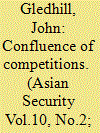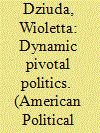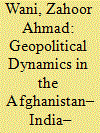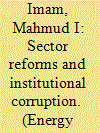|
|
|
Sort Order |
|
|
|
Items / Page
|
|
|
|
|
|
|
| Srl | Item |
| 1 |
ID:
133090


|
|
|
|
|
| Publication |
2014.
|
| Summary/Abstract |
In April 2006, riots broke out on the streets of Dili. As violence escalated over the weeks that followed, a beacon of liberal peace-building dissolved into near-anarchy. While there have been several accounts of Timor-Leste's "crisis" of 2006, it remains unclear why violence spiraled at that time, rather than at an earlier point in the country's post-conflict transition. This article addresses that temporal puzzle by combining an analysis of the structural origins of the crisis with discussion of proximate, agency-driven triggers to violence. The resulting narrative first details the development of competition between governing elites, and also between state security actors, over the years following independence. The fusion of those two dynamics of competition in 2006, I then argue, created conditions sufficient for violent conflict.
|
|
|
|
|
|
|
|
|
|
|
|
|
|
|
|
| 2 |
ID:
160558


|
|
|
|
|
| Summary/Abstract |
We analyze a dynamic extension of a parsimonious model of lawmaking in which preferences evolve over time and today’s policy becomes tomorrow’s status quo. Unlike in existing models of pivotal politics, policy makers’ voting behavior depends on the institutional environment and on their expectations about future economic and political shocks. Relative to sincere voting, the equilibrium behavior exhibits a strategic polarization effect, which increases with the degree of consensus required by the institution, the volatility of the policy environment, and the expected ideological polarization of the future policy makers. The equilibrium behavior also exhibits a strategic policy bias, which works against any exogenous policy bias embedded in the voting rule. Our analysis implies that the existing literature underestimates the inertial effect of checks and balances and overestimates the impact of institutional biases such as fiscally conservative budget procedures.
|
|
|
|
|
|
|
|
|
|
|
|
|
|
|
|
| 3 |
ID:
084411


|
|
|
| 4 |
ID:
131544


|
|
|
|
|
| Publication |
2014.
|
| Summary/Abstract |
Aspects of space and place shape daily life, social structures, politics, and intimate relations among people. In the late 1980s and 1990s, anthropologists, geographers, and sociologists-influenced by the writings of Michel Foucault and Henri Lefebvre on the meaning of social space-started to highlight the spatial in their analysis of social phenomena. These scholars focused on the production of urban space and asserted that space is dynamic and often shaped by the needs of its users as well as by those who design it. With the exception of Setha Low's work on Latin America, these writings were mostly centered on the United States.
|
|
|
|
|
|
|
|
|
|
|
|
|
|
|
|
| 5 |
ID:
188813


|
|
|
|
|
| Summary/Abstract |
Since the partition of the subcontinent in 1947, the geopolitics of South Asia has been shaped by a dynamic triangular relationship among Afghanistan, India and Pakistan on which depend prospects of peace, governance and stability in the South Asian region. This article examines how and why the Afghanistan–India–Pakistan triangle emerged and how it affects the entire South Asian region as a matter of geopolitics. The article also analyses why major strategic and political shifts occurred in these complex relations after the fall of the Taliban rule in Afghanistan in 2001 and ventures to provide some comments on more recent developments. The evolution and nature of the triangular engagements lie in the overlapping policies of these three countries. Hence, I identify their interactions as constituting a dynamic triangle. This article argues that strategic positioning and concerns and claims for political space have shaped their relationship to such an extent that if something bad happens in one of the three countries, this affects the position of the other two as well. That is why the current re-alignments in Afghanistan have crucial implications for the whole region, not just in terms of their respective foreign policy objectives but also for the long-term harmony, peace, progress and stability in the whole region.
|
|
|
|
|
|
|
|
|
|
|
|
|
|
|
|
| 6 |
ID:
166470


|
|
|
|
|
| Summary/Abstract |
In order to reduce the influence of corruption on electricity sector performance, most Sub-Saharan African countries have implemented electricity sector reforms. However, after nearly two and half decades of reforms, there is no evidence whether the reforms have mitigated corruption. Neither is there evidence of performance improvement of the reforms in terms of technical, economic or welfare impact. This paper aims to fill this gap. We use a dynamic panel estimator with a novel panel data of 47 Sub-Saharan African countries from 2002 to 2013. We analyse the impact of corruption and two key aspects of electricity reforms – creations of independent regulatory agencies and private sector participation – on three key performance indicators: technical efficiency, access to electricity and income. We find that corruption can significantly reduce technical efficiency of the sector and constrain the efforts to increase access to electricity and national income. The adverse effects are reduced where independent regulatory agencies are established and privatisation is implemented. These findings suggest that well-designed reforms not only boost the performance of the sector directly, but also indirectly reduce the negative effects of macro level institutional deficiencies such as corruption on micro and macro performance indicators.
|
|
|
|
|
|
|
|
|
|
|
|
|
|
|
|
| 7 |
ID:
182719


|
|
|
|
|
| Summary/Abstract |
This paper examines the impact of structural change in China, in particular a reduction in the savings rate, an increase in the share of skilled workers, and an increase in productivity in technologically advanced manufacturing sectors targeted by Made in China 2025. Baseline projections until 2040 are generated with the WTO Global Trade Model, a dynamic computable general equilibrium model. With the modelled structural changes, the Chinese economy is projected to reorient its focus increasingly onto the domestic economy, raising the share of private household and government consumption in GDP, turning China's trade surplus into a trade deficit, reducing China's share in global exports, raising the share of services in both production and exports, shifting the destination markets of Chinese exports from developed to developing countries, and changing its pattern of comparative advantage away from sectors like light and heavy manufacturing to electronic and machinery equipment. The large bilateral trade surplus vis-a-vis the United States is projected to fall to almost zero.
|
|
|
|
|
|
|
|
|
|
|
|
|
|
|
|
|
|
|
|
|